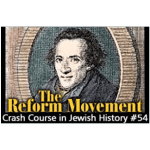History Crash Course #62: Return to the Land of Israel
The yearning for the land of Israel never left the Jewish people.
- We see it in Psalms that Jews constantly recited: “If I forget you, O Jerusalem …” or “When the Lord brings about our return to Zion, we will be like dreamers…”
- In the statements of the rabbis, such as his one by Rabbi Nachman of Breslav: “Wherever I go I’m always going to Israel.”
- We see it in Jewish poetry, such as that of Yehuda HaLevi: “My heart is in the East but I am in the most far West.”
- In holiday rituals: “Next year in Jerusalem.”
- And, of course, in countless blessings recited daily: “Have mercy, Lord our God, on Israel your people, on Jerusalem, your city, on Zion… Rebuild Jerusalem, your holy city, speedily in our days, and bring us there to rejoice in its rebuilding…”
In other words, the land of Israel was always a place in the minds of the Jews where the Jewish national potential could someday be fulfilled.
But, as a practical reality, this did not begin to happen in a significant way until the birth of modern Zionism, not as a religious, but as a political movement.
The re-birth of Israel is an unprecedented phenomenon in human history. That a people should go into exile, be dispersed, and yet survive for 2,000 years, that they should be a nation without a national homeland and come back again, that they should re-establish that homeland is a miraculous, singular event. No one ever did such a thing.
Brief Overview
Before we discuss the Jews’ return to their homeland, let us then look back at history and review briefly what had been happening in the Land of Israel from the time that the Temple was destroyed by the Romans in 70 CE, (See Parts 35 thru 37.)
Subsequently, Jerusalem was leveled, rebuilt on the Roman model, and renamed Aeolia Capitolina. The land of Israel was renamed Palestine (after the extinct Philistines, some of the worst enemies of the Jews in ancient times).
Once the Muslims took over the Land of Israel, they held onto it with the brief exception of the period of the Crusades. (See Part 45.)
The Turkish Ottoman Empire held onto power here the longest: from 1518 to 1917. Yet, during all this time, the Muslims generally treated the Holy Land as a backwater province. There was no attempt to make Jerusalem, which was quite run-down, an important capital city and only a few Muslim dynasties attempted to improve its infrastructure (save for Umayyads in the 7th century, the Mameluks in the 13th century the rebuilding of the walls of the city in 16th century during the reign of the Ottoman Sultan Suleiman the Magnificent.) Similarly, only limited building went on in the rest of the land, which was barren and not populated by many Arabs. The only major new city built was Ramle, which served as the Ottoman administrative center.
Mark Twain who visited Israel in 1867 described it like this in Innocents Abroad:
We traversed some miles of desolate country whose soil is rich enough but is given wholly to weeds ― a silent, mournful expanse… A desolation is here that not even imagination can grace with the pomp of life and action. We reached Tabor safely… We never saw a human being on the whole route. We pressed on toward the goal of our crusade, renowned Jerusalem. The further we went the hotter the sun got and the more rocky and bare, repulsive and dreary the landscape became… There was hardly a tree or a shrub anywhere. Even the olive and the cactus, those fast friends of a worthless soil, had almost deserted the country. No landscape exists that is more tiresome to the eye than that which bounds the approaches to Jerusalem… Jerusalem is mournful, dreary and lifeless. I would not desire to live here. It is a hopeless, dreary, heartbroken land… Palestine sits in sackcloth and ashes.”
Early Migrations
During the time of the Muslims, life for the Jews here was for the most part easier than under the Christians.
In 1210, following the demise of the Crusaders, several hundred rabbis, known as the Ba’alei Tosefot, re-settled in Israel. This marked the emergence of the first Ashkenazic European community in Israel.
In 1263, the great Rabbi and scholar Nachmanides also known as the Ramban, established a small Sephardic community on Mount Zion which was outside the walls. (See Part 47.) Later, in the 1400s, that community moved inside the walls and they established the Ramban Synagogue which still exists today.
When Nachmanides came to Jerusalem there was already a vibrant Jewish community in Hebron, though the Muslims did not permit them entry into the Cave of the Machpela (where the Jewish Patriarchs and Matriarchs are buried). Indeed, this ban continued until the 20th century.
More Jews started to migrate to Israel following their expulsion from Spain in 1492. In the 16th century, large numbers of Jews migrated to the northern city of Tzfat (also known as Safed) and it became the largest Jewish population in Israel and the center of Jewish mysticism ― the Kabbalah.
In mid-1700s a student of the Ba’al Shem Tov by the name of Gershon Kitover started the first Hassidic community in Israel. This community was part of what was called Old Yishuv. (Today, when in the Old City of Jerusalem, you can visit the “Old Yishuv Court Museum” and learn some fascinating facts about it.)
Another very significant event in the growth of the Jewish community of Israel took place in the early 19th century. Between 1808 and 1812 three groups of disciples of the great rabbi Rabbi Eliyahu Kramer, the Vilna Gaon , numbering about 500 people, came to the land of Israel. Initially they settled in Tzfat in the Galilee, but after several disaster including a devastating earthquake, they settled in Jerusalem. Their impact was tremendous. They founded several new neighborhoods (including Mea Shearim) and set up numerous Kollels (Yeshivot where married men are paid a monthly stipend to study Torah). Their arrival revived the presence of Ashkenazi Jewry in Jerusalem, which for over 100 years had been mainly Sephardi and had a huge impact on the customs and religious practices of the religious community in Israel.
By 1880, there were about 40,000 Jews, living in the land of Israel among some 400,000 Muslims.[1]For detailed information on the demographics of Palestine during the Ottoman and British Mandates periods see: Joan Peters, From Time Immemorial ― The Origins of the Arab-Jewish Conflict Over … Continue reading)
One of the major figures of this time period was Moses Montefiore (1784 to 1887) ― the first Jew to be knighted in Britain.
Montefiore had made his fortune with the Rothschilds, who struck it rich in the Napoleonic Wars. They used carrier pigeons and they knew about the victory at Waterloo before anyone else; this is how they made a killing on the English stock market.
With his fortune made by age 40, Montefiore embarked on a career in philanthropy, becoming a tireless worker for the Jewish community of Israel.
At that time, most of the Jews then lived in what is now called the Old City of Jerusalem, specifically in what is now called the “Moslem Quarter.” The main entrance to the city for the Jews was through Damascus Gate and of the many synagogues in Jerusalem, many f them were in the “Moslem Quarter” close to the site where the Temple stood on Mount Moriah.
The city was hugely overcrowded and sanitary conditions were terrible, but due to the lawlessness of that time, people were afraid to built homes and live outside.
Montefiore built the first settlement outside the walls of the Old City, called “Yemin Moshe” in 1858. He opened the door and more neighborhoods were built in the New City. One of the earliest ones, built in 1875, was Mea Shearim (which, contrary to popular opinion does not mean “Hundred Gates” but “Hundredfold” as in Genesis 26:12.)
Besides Montefiore, another extremely important personality in this period of time was Baron Edmond de Rothschild (1845 to 1934).
Rothschild was a man who more than anyone else, financially made the re-settlement of Jews in the land of Israel possible. During his lifetime he spent 70 million francs of his own money on various agricultural settlements (Rosh Pina, Zichron Yacov, Pardes Hannah to name but a few) and business enterprises such as the Carmel Winery for example. So important and generous was Rothschild that he was nicknamed HaNadiv HaYaduah, “The Famous Contributor.”
Although Rothschild was quite assimilated and disconnected from the Jewish yearning for the land, he was greatly influenced by Rabbi Shmuel Mohilever, who was one of the first religious Zionists from Poland.
Mohilever converted Rothschild to his ideology and from that point on the rich banker began to look at Israel as an “investment.” He made it possible for thousands of Jews to return to the land and survive here in those days.
Early Political Zionism
We do not see the appearance of political Zionism until late in the 19th century as a reaction to the intolerable persecution of the Jews of Russia.
The early political Zionists, being largely secular (many had in fact been born into observant homes and then later dropped their observance), did not feel a special yearning for Israel rooted in tradition or religion, rather they felt that the Land of Israel was the only place where Jews could create a national identity, regain their pride and productivity, and hopefully escape the horrible anti-Semitism of Czarist Russia and other places.
One of the main organizations involved in early political Zionism was called Hibbat Zion “the love of Zion” founded in 1870. (Its members were called Hovevei Zion, “lovers of Zion.”)
A major personality among the Hovevi Zion was Judah Leob Pinsker (1821-1891). A Polish doctor, Pinsker started out as one of the Maskilim, a group which wanted their fellow Jews to drop Judaism and merge with Russian culture in the hope that if Jews were socially accepted, then Russian anti-Semitism would disappear. (See Part 56.) But after the pogroms following the assassination of Czar Alexander in 1881, he and many other of the Maskilim came to the conclusion that their efforts were futile and anti-Semitism was never going to disappear. Like Theodor Herzl later, Pinsker was shocked at the depth of European anti-Semitism. The only solution, he came to believe, was for Jews to live in their own national homeland. Pinsker published his ideas in a pamphlet called “Auto-Emancipation.” In it he penned these memorable words:
“We must reconcile ourselves to the idea that the other nations, by reason of their inherent natural antagonism, will forever reject us.”
First Aliyah
In 1882, another important organization was formed in Russia. It was called Bilu, an acronym of the opening words from verse in Isaiah (2:5): Beit Yaacov lechu Venelech meaning, “House of Jacob, come, let us go…
Bilu was very active in the early settlement movement, what came to be called the “First Aliyah” ― the first large migration of Jews from Russia and Romania to the Land of Israel.
Aliyah means “ascent.” To migrate to Israel ― to make aliyah ― means to come from a low place and to “go up.” (In antiquity the term Aliyah referred to a trip to Jerusalem to visit the Temple, usually during one of the pilgrim festivals: Passover, Shavuot or Succoth, and implied more than a trip up to the mountains surrounding Jerusalem but more importantly to go up to the holiest place on earth ― the Temple.)
The year 1882 marked the first such aliyah, when Jews began to arrive in the land of Israel in droves ― some 30,000 Jews came in two waves between 1882-1891 and founded 28 new settlements.
(Among these new settlements was Hadera, which has been so much in the news lately as the repeated target of vicious terrorist attacks.)
Hundreds of thousands of acres were purchased by these early Zionists from absentee Arab landowners who usually lived elsewhere in the Middle East. The majority of the lands purchased were in areas that were neglected and considered un-developable ― such as the sandy coastal plain or the swampy; malaria infested Hula Valley in the north. Amazingly, and with much effort, these early settlers made the barren land bloom again and drained the swamps.[2]The Hula Valley was not drained until the 1950s.
What drove many of these early immigrants was an idealism that was captured by Zev Dugnov, a member of Bilu:
My final purpose is to take possession of Palestine and to restore to the Jews the political independence for which they have now been denied for two thousand years. Don’t laugh. It is not a mirage. It does not matter if that splendid day will come in 50 years’ time or more. A period of 50 years is no more than a moment of time for such an undertaking.
In fact, it would take 66 years. Meanwhile, Jews would continue to come, reclaim the land and build a strong political movement demanding back their ancient homeland.










